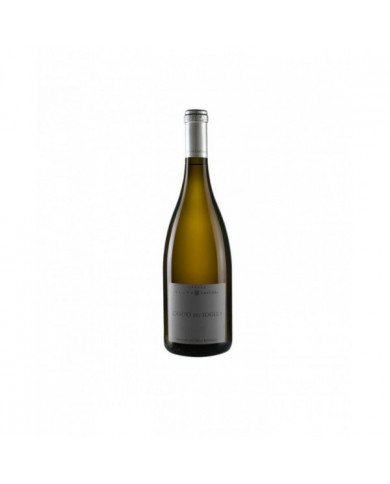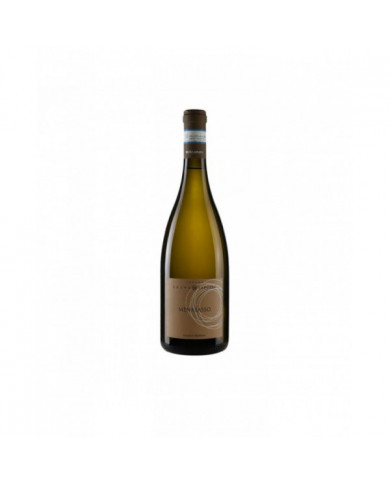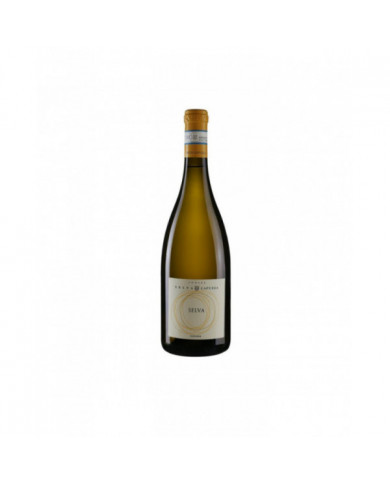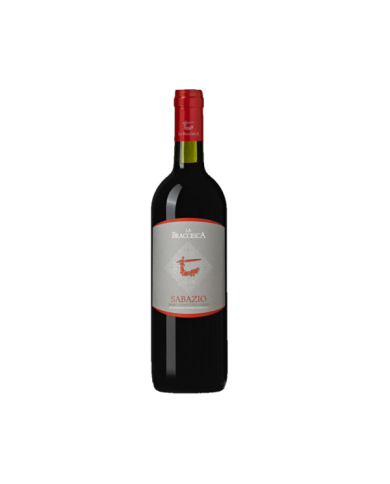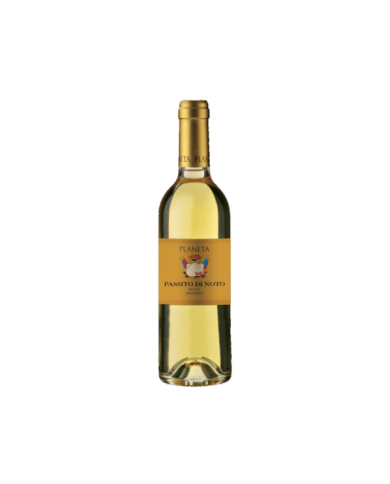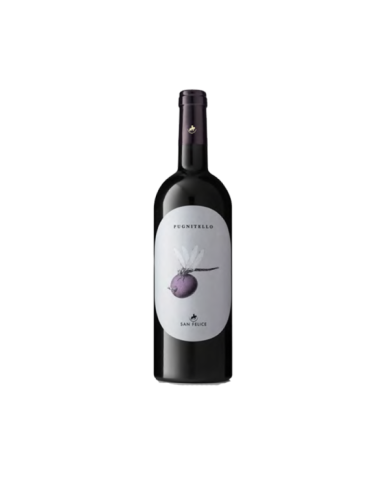SKU: 13003
Brand: Ruggieri
Color : straw yellow Bouquet : scent of white flowers and fruit Taste : fresh and persistent Serving temperature : 10-12 ° C Pairings : particularly suitable with fish and white meat dishes Harvest : manual
SKU: 9844
Brand: PODERE SELVA CAPUZZA
Fruity, floral and with a tendency to mineral on the nose, it presents itself to the taste with freshness and sapidity which once again dominates and guides towards a structure full of character and balance. It is a wine that manages to express remarkable shelf life at the same time as a certain pulpiness and finesse. Selva is one of the first crus born in this production area and is one of the company's most striking expressions of identity. It is in fact produced from the ripest vineyard of Selva Capuzza and fully reflects its uniqueness.
SKU: 17012
Brand: Tenuta Viglione
A sweet white sparkling wine with a golden yellow color and a floral aroma with citrus notes, hints of honey and candied citrus peel.
SKU: 3842
Brand: Dora Sarchese
Grapes used: Cococciola 50%, Trebbiano 30, Chardonnay 20%.
Vinification: the harvest takes place manually in boxes, carefully selecting the best bunches. In the cellar the grapes are subjected to soft pressing and the must is fermented in stainless steel tanks at a controlled temperature of 16-18 ° C. Assembled the various fractions to form the cuvèe, the base wine is placed in the bottle with selected yeasts where the second fermentation and subsequent refinement will take place following the Classic Method sparkling process.
SKU: 15676
Brand: Dei Principi di Spadafora
It is a fresh and elegant wine, with a superior structure to the white Don Pietro, included in the Don Pietro line. 7,000 bottles come out.
SKU: 5980
Brand: San Felice
40 years after the acquisition of the Campogiovanni estate in Montalcino, San Felice 's interest has shifted to another area of Tuscan wine excellence: Bolgheri. Faithful to its philosophy of producing exclusively wines from proprietary grapes, 6 hectares of vineyards have been identified in Le Sondraie. The vines have an average age of 5 years and are planted on a silt-sandy soil typical of the area. The varieties are mainly Cabernet Sauvignon (2 ha) and Merlot (4 ha). Two wines are produced: Bolgheri and Bolgheri Superiore.
SKU: 5907
Brand: San Felice
La Vigna Del Lago It can happen to come across unexpected places, the Vigna del Lago, as in this 100% Chardonnay, unexpected white single-vineyard and newcomer in the San Felice house of particular aromatic freshness and flavor, carefully selected grapes and soil with unique characteristics, on which traces of the ancient Etruscan presence remain.
The best Italian white wines
Italy is home to important white wines. In the section of our Clickwine online wine shop dedicated to the best Italian white wines, you will find bottles of excellent white wine carefully selected by our Sommeliers.
The denominations used in our country to classify wines are DOCG, DOC and IGT. Sometimes denominations such as DOP and IGP are also found: these acronyms have similar meanings to the previous ones but are used by wineries that mainly sell their wines outside the Italian territory.
The production of white wine
White wines are produced from both light and dark berry grapes, but vinified in white: that is to say that during maceration there is no contact between the must and the marc, so that the skin - exactly the opposite of what it happens for the red - it doesn't give substances and color.
Its myriad nuances vary according to the characteristics of the vine, the refinement method and the vine cultivation area.
In white winemaking, once the grapes have been harvested, they are transported to the cellar, destemmed and pressed and the must is separated without any maceration or with a short maceration. Sometimes, however, the grapes are pressed and then macerated with the skins at a low temperature for a more or less long period. In this way, richer and softer wines can be obtained.
This phase is followed by the clarification of the white product, which can be done by letting the must rest, by cooling, centrifugation or filtration.
Fermentation begins either by introducing selected yeast into the must or spontaneously, with the indigenous yeasts present in the grapes. To maintain the aromas, finesse and freshness of white wines, fermentation is done at lower temperatures than for red wine vinification, generally around 18°C.
To obtain a fresh and lively wine, to be drunk young, malolactic fermentation is avoided, bottling early, after filtration and stabilization. More complex wines, aged or fermented in wood, are bottled only after several months spent in barrels.
How to taste white wine
First of all, you need to decide whether to uncork the bottle immediately or whether to age your white wine. If you want to immediately surrender to their charm, their aromas of aromatic herbs, flint or their notes of exotic fruit, then serve your white at the right temperature: 6-8° for a young white and 8-10° for a softer one. it is structured.
How to match white wine
Dry white wines will also surprise you at the table and not just for their straw yellow colour. As an aperitif and above all combined with a fish dish, white wine is certainly a must, but it is not easy to perceive which of the many labels will be the most suitable for the occasion
However, we suggest you try some white wine as an accompaniment to fresh, low-fat cheeses rich in milk such as the tasty buffalo mozzarella, or with soft, flowery-rind cheeses. They are obviously also perfect with white meats, such as the classic scallops but beyond the customs, white wine also perfectly decorates a table based on meat and risottos as well as truffles. Enter our Clickwine online wine shop to receive specific suggestions for buying the best white wine at the best price to pair with your favorite dishes.
White wines: prices and offers
Every week you will find on our Clickwine online wine shop selected white wine labels at special prices in this section and in the one dedicated to offers, you can then take a look at those with the best value for money.
A wide choice of quality products is available at affordable and truly exclusive prices. Do not miss the incredible offers of white wines belonging to all the most prestigious wineries of Italian production, discover Italian wines loved and internationally recognized.
Enter the Clickwine catalog and expand your choice by purchasing online exclusive articles of small-sized wineries, but with an exceptional production of the highest quality.
White wines: longevity and conservation
How long can I keep white wine in the cellar? Do white wines improve like red wines with age? These are the questions that a wine consumer asks himself when speaking of white wine.
In general, white wines are much less long-lived than reds, for two reasons: the tannins and the ageing. Tannins are antioxidant substances present in the skins of wine which are not present in whites; As far as aging is concerned, however, most of the white wines are aged in steel for a few months, even the reds, if they are aged a little in steel and undergo rapid maceration, do not last many years. Let's say that a classic white that ages in steel lasts from 2 to 3 years maximum. If it is macerated or aged in wood, it can last up to 20 years and improve from year to year.
How many types of white wines are there?
There is no exact number of types of white wines, as there are different white grape varieties that can be used to make white wines. Some of the most common white grape varieties used to produce white wines are: Chardonnay, Sauvignon Blanc, Riesling, Pinot Grigio and Moscato. There are also other less common varieties such as Gewürztraminer, Semillon and Viognier. Each of these varieties can be used to make white wines with different and unique characteristics, so there are many different types of white wines available.
How to recognize a good white wine?
There are several ways to recognize a good white wine. One of the easiest ways is to taste the wine and evaluate its taste and aroma. A good white wine should have a pleasant taste and a delicate, complex aroma. Other factors that can indicate the quality of a white wine are the vintage, the grape variety and the production area. In general, white wines produced with high quality grapes and in particularly favorable years tend to be more valuable and of higher quality. Furthermore, white wines produced in regions renowned for the production of high quality white wines can be considered more valuable than the ones produced in other regions.
How to understand if a white wine is good?
As mentioned above, one of the easiest ways to understand if a white wine is good is to taste it and evaluate its taste and aroma. A good white wine should have a pleasant taste and a delicate, complex aroma. Furthermore, it is important to keep in mind the quality of a white wine can be influenced by many factors, such as the vintage, the grape variety and the production area. For example, white wines produced with high quality grapes and in particularly favorable years tend to be more valuable and of higher quality. Furthermore, white wines produced in regions renowned for the production of high quality white wines can be considered more valuable than the ones produced in other regions.
Why is it called white wine?
White wine is called this way because it is produced using white grapes. Most of the white grapes have a transparent or slightly colored skin, therefore the wine produced with these grapes has a clear and transparent colour. Sometimes the color of white wine can be influenced by the type of grape used, the winemaking process and the addition of other ingredients, but in general, white wine has a clear, transparent color.
How to replace white wine?
If you want to substitute white wine in a recipe, there are several ingredients you can use. One of the more common options is to use chicken or vegetable broth instead of white wine. Other options may include using white vinegar or apple juice diluted with water. Also, in some cases you can omit the white wine entirely and use other ingredients to achieve the desired flavor in the recipe.


